Monday, November 11, 1918. The Chicago Tribune received an alert from the Associated Press at 1:55 a.m.: “Armistice signed.” There had been a false alert on Thursday, so the news was checked and double-checked, but this time it was true: After four long years, World War I was finally over.
As we mark the 100th anniversary of the war’s end, here’s a look at how Chicago celebrated, culled from local newspaper accounts, including the November 11 and 12, 1918, editions of the Chicago Daily News, the Chicago Daily Journal, the Chicago Evening Post, Chicago Examiner, Chicago Herald and Examiner and the Chicago Daily Tribune.
The Tribune set off giant sirens, as did other newspapers. Police and fire departments were notified, and they started spreading the news. Fireboats set off their sirens. Policemen walked through the empty streets, yelling, “The war is over! The war is over!”
Within minutes, people poured onto the streets. The crowds lasted all day as civilians, soldiers and sailors boarded trains to celebrate at State and Madison, “the busiest corner in the world.”
The Loop was the place to be. And the best way to celebrate was to make noise. Besides the sirens, people banged dishpans, blew horns and whistles, shook rattles and shot guns into the air. Train whistles shrieked non-stop. Ringing alarm clocks were even hung out of windows.
Spontaneous parades, mock funeral processions (for the exiled German kaiser) and bonfires erupted all over the city. The bonfire at Wilson and Broadway attracted over 500 people by 4 p.m.
At the Federal Building, the Commonwealth Edison company band led a parade all over the building and through the rotunda, ending in a courtroom where everybody, including the judge, cleared the floor of furniture and turned it into a dance floor.
There was an effort to contain the celebrating in the Loop with a parade starting at the Municipal Pier (now Navy Pier) and ending at a large rally at the Chicago Coliseum at East 16th and Wabash. It was a good try, but people were more interested in the party at the Loop.
The celebration continued all day and into the night. Bars were allowed to stay open. The festivities finally started to peter out around 1:30 a.m. Tuesday. The police department officially ended the party with a 7 a.m. curfew.
On Tuesday, Chicago went back to work and back to school. Nine people died and 30 were hurt, mostly from car accidents and accidental shootings. A couple hundred people who had been locked up overnight for celebrating a little too hard were released Tuesday morning. Police commented that, despite the non-stop noise for over 24 hours, the crowds had been good-natured and (relatively) well-behaved. Not bad for a crowd estimated to be around a million people.
You can read more in our Chicago Newspaper collection at Harold Washington Library Center and in the World War I Collection in the Special Collections and Preservation Division.
Want to learn more about the end of World War I? Check out these books: The Greatest Day in History and Eleventh Month, Eleventh Day, Eleventh Hour
To read about how wartime reporting changed during World War I, check out American Journalists in the Great War.
For more recommendations, see our World War I booklist.

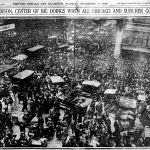
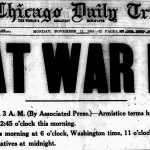
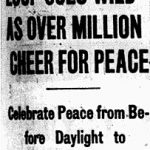

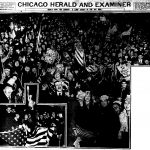
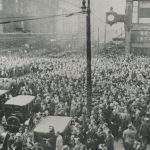

Add a comment to: 100 Years Ago: Chicago Celebrated the End of WWI